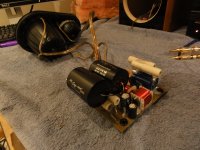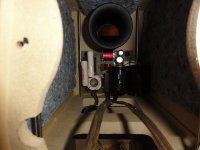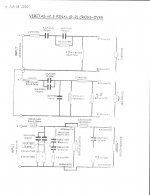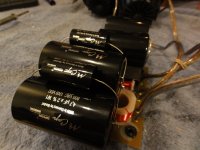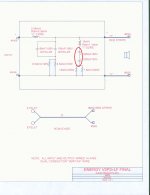Actually I didn't spend any cash so far beyond buying the speakers second hand last week. The crossover fix was free so I'm a Happy Camper! I'm grooving to some Monk on SACD right now
Thats good lol
Had the trace not been cut the first 2.7 ohm resistor in the tweeter circuit would be bypassed, so clearly the cut was put there by the manufacturer to make up for a board design error.
After putting the board back in the speaker I listened over and over to a particular music passage where the static was unmistakable before, and there's no more static
Great job... amazing (energy needed to fix it's own fix), big potential to blow the tweeter I bet!, bypassing that resistor ups the volume, it's a ticking time bomb--
Great job... amazing (energy needed to fix it's own fix), big potential to blow the tweeter I bet!, bypassing that resistor ups the volume, it's a ticking time bomb--
Yeah, it looks like someone replaced the tweeter diaphragm in this speaker once already. They should be good for years to come now this is fixed.
Id love to hear your impressions when you have it all put back together.
I definitely will as it progresses!-- here is a pic with the mundorf silver/oil midrange capacitors and resistors soldered in. it's going to barely fit after the tweeter capacitors and ERSE midrange inductor is in!
there will prob be a long break-in time, the caps are rated at 1200VDC
Attachments
Last edited:
I definitely will as it progresses!-- here is a pic with the mundorf silver/oil midrange capacitors and resistors soldered in. it's going to barely fit after the tweeter capacitors and ERSE midrange inductor is in!
there will prob be a long break-in time, the caps are rated at 1200VDC
Those caps are huge lol
XO Questions
I want to upgrade my xo in my Energy Veritas 2.3's . Can anyone tell me what needs to be replaced and what needs to be left alone?
There are some caps In the lower woofer xo that are rated at 1200uf/100v electrolytic. What Is there purpose? Also beside it there is the 100uf/100v Bi polar, 47uf/100v bi polar and a 33uf/100v bi polar. These values will cost me a fortune to replace.
Any hep would be a great help.
I want to upgrade my xo in my Energy Veritas 2.3's . Can anyone tell me what needs to be replaced and what needs to be left alone?
There are some caps In the lower woofer xo that are rated at 1200uf/100v electrolytic. What Is there purpose? Also beside it there is the 100uf/100v Bi polar, 47uf/100v bi polar and a 33uf/100v bi polar. These values will cost me a fortune to replace.
Any hep would be a great help.
I want to upgrade my xo in my Energy Veritas 2.3's . Can anyone tell me what needs to be replaced and what needs to be left alone?
There are some caps In the lower woofer xo that are rated at 1200uf/100v electrolytic. What Is there purpose? Also beside it there is the 100uf/100v Bi polar, 47uf/100v bi polar and a 33uf/100v bi polar. These values will cost me a fortune to replace.
Any hep would be a great help.
I don't see any obvious places for upgrades myself, Energy didn't blatantly cut corners in the sense that they used good quality film caps for all the series positions. If you want to spend some money you could try substituting some esoteric caps in these places. An alternative to replacing the larger electrolytics is to wire some small value film caps in parallel with them; just be sure to use less than 5% of the of the existing cap's value.
Note that bi-polar just means a cap is non-directional rather than refering to the material it's made from. Most of the time ALL caps used in crossovers are bi-polar (aka non-polar or NP). The schematic suggests that the 1200uf caps you mentioned are actually directional, however they've been wired with the positives together in series so they'll operate like a bi-polar. I suspect these caps are used as part of Zobel network, but I'm not an expert so someone could well correct me.
fyi, my system
Squeezebox Touch (w/Touch Toolbox 2.0 mods)
PSaudio DLIII DAC (Cullen level 4 mods)
PSaudio Trio C-100 Amp (Cullen level 3 mods)
Energy Veritas 2.2i speakers
Martin Logan Depth i (x2)
PSaudio Duet
PSaudio ac3 power cables
Cardas clear light interconnect (this is awesome)
Black cat veloce digital cable
Audioquest slate biwire spkr cables
iPad remote control
Squeezebox Touch (w/Touch Toolbox 2.0 mods)
PSaudio DLIII DAC (Cullen level 4 mods)
PSaudio Trio C-100 Amp (Cullen level 3 mods)
Energy Veritas 2.2i speakers
Martin Logan Depth i (x2)
PSaudio Duet
PSaudio ac3 power cables
Cardas clear light interconnect (this is awesome)
Black cat veloce digital cable
Audioquest slate biwire spkr cables
iPad remote control
fyi, here's the crossover board so far with the tweeter & midrange caps soldered in (resistors are underneath hidden) -- they are back in the speakers & work
They look great, how do they sound? Any idea what the break-in time is for caps like those?
They look great, how do they sound? Any idea what the break-in time is for caps like those?
Thanks!
The difference in sound is hard to describe, it's like the original caps emphasised all the fine details, so they got in their own way-- now that emphasis is gone, and you can hear far *more* detail! -- also the sound is freakishly juicy/fluid, the original caps are hashy/grainy compared to these, and I thought the speakers *were* fluid until I heard these! also, now I know what a 3d sound stage sounds like! before it was layered & with depth, but each layer was 2d!
this is how they sound now after about 1 week playing continuously, i've heard they take a long time to break in, not sure
Last edited:
Cool. What kind of resistors did you use? Are the smaller parallel caps just to help you reach the required values?
mundorf supreme resistors (20W)
thats correct on the parallel caps:
for the two 5uF tweeter caps, had to use 4.7uF + 0.33uF
for the 6uF midrange, used 3.3uf + 2.7uF
so 6 new capacitors, 4 new resistors each high/mid crossover! (also the mid has a new erse inductor)
you should see the pile of old parts replaced!
Last edited:
please also see this thread
http://www.diyaudio.com/forums/multi-way/185178-polypropylene-mega-cap.html#post2505844
http://www.diyaudio.com/forums/multi-way/185178-polypropylene-mega-cap.html#post2505844
The schematic suggests that the 1200uf caps you mentioned are actually directional, however they've been wired with the positives together in series so they'll operate like a bi-polar. I suspect these caps are used as part of Zobel network, but I'm not an expert so someone could well correct me.
I don't know all the tech details, but that part of the circuit looks like it controls how the bass speaker drivers *dual* voice coils operate (separating the positive negative (or something like that))
what is a nice replacement for a 1200uF polarized cap?
Attachments
Last edited:
I don't know all the tech details, but that part of the circuit looks like it controls how the bass speaker drivers *dual* voice coils operate (separating the positive negative (or something like that))
what is a nice replacement for a 1200uF polarized cap?
You're suggesting there's some sort of phase inverter in the crossover? Even if that was possible the woofers in question don't have separate connections for each of the two voice coils which Energy supposedly put in them. If they did have separate connectors, and they are wired in opposing directions, you would simply wire them out of phase from each other in order to get them to work in the same together, you wouldn't need some special circuit in the crossover.
You're suggesting there's some sort of phase inverter in the crossover? Even if that was possible the woofers in question don't have separate connections for each of the two voice coils which Energy supposedly put in them. If they did have separate connectors, and they are wired in opposing directions, you would simply wire them out of phase from each other in order to get them to work in the same together, you wouldn't need some special circuit in the crossover.
I was just guessing & trying to start a conversation on it-- I *do* know the woofers have dual voice coils, and that makes sense-- must be wired internally inverted--
what is the purpose of the 2 1200uF caps circled in post #56? do they actually add up to 600uF since they are in series?
I don't know all the tech details, but that part of the circuit looks like it controls how the bass speaker drivers *dual* voice coils operate (separating the positive negative (or something like that))
what is a nice replacement for a 1200uF polarized cap?
Here is a quote from David Schulte, Upgrade Company
"The 1200uF caps are part of an LCR-network that flattens the impedance peak at the woofer / cabinet resonance frequency. They are polar electrolytics, putting them back to back makes 600uF bipolar."
Here is a quote from David Schulte, Upgrade Company
"The 1200uF caps are part of an LCR-network that flattens the impedance peak at the woofer / cabinet resonance frequency. They are polar electrolytics, putting them back to back makes 600uF bipolar."
Thanks Miles, that confirms it's what I said in post 48: those caps are part of a Zobel network and work like a bi-polar.
Last edited:
- Home
- Loudspeakers
- Multi-Way
- energy veritas 2.2i crossover project
